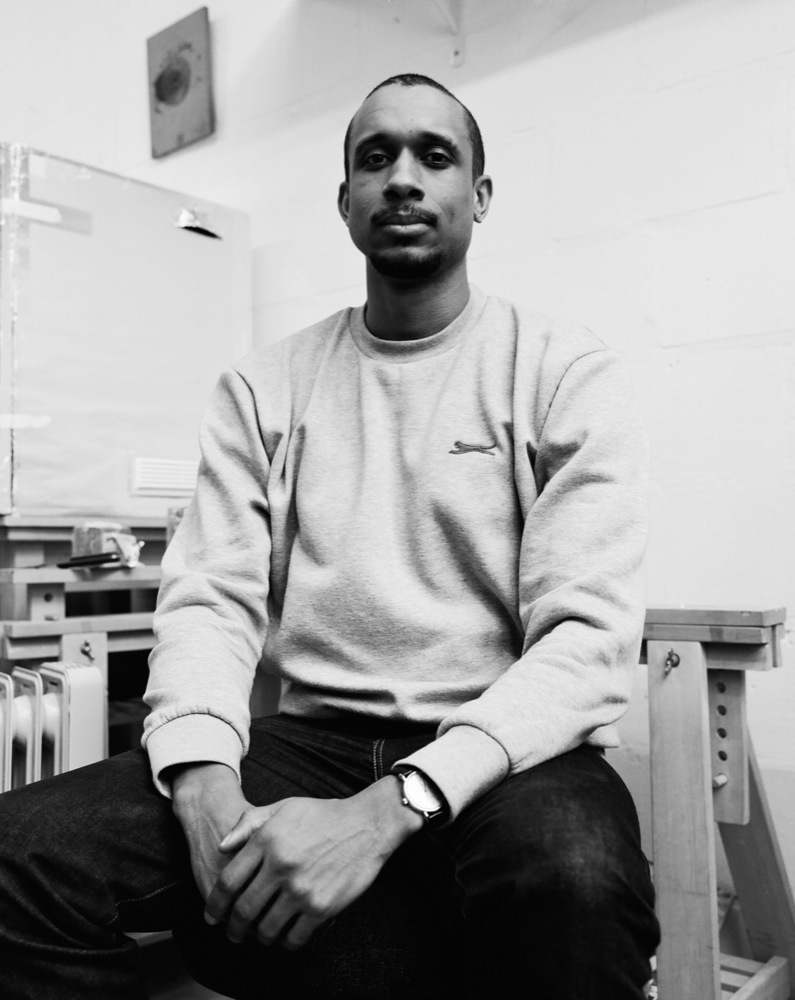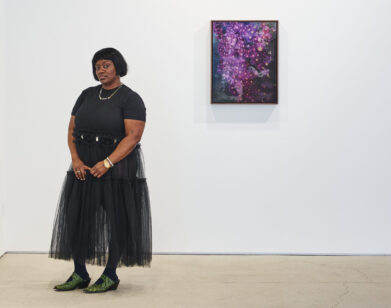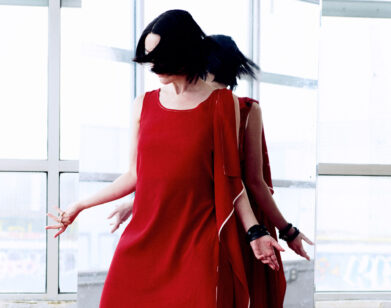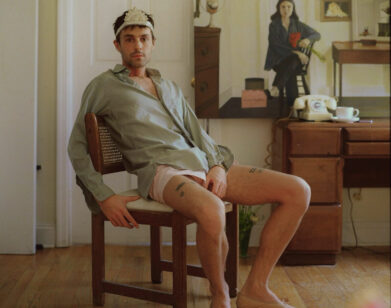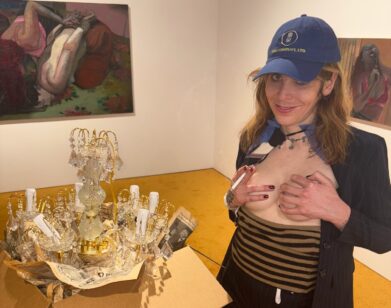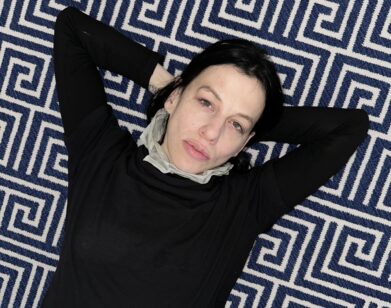Thomas J Price’s Sculptural Investigations
THOMAS J PRICE IN LONDON, MARCH 2016. PHOTOS: DAN WILTON.
“Tom, what the fuck are you gonna do? You’re dyslexic, you can’t do math, you don’t like taking orders, and you argue all the time. So what are you going to do?” In his teens, this is precisely what sculptor Thomas J Price asked himself. Born in pre-gentrification South London and raised on a council estate, Price was determined to keep his options in life open—and find one that suited his personality. His curiosity and drive eventually landed him at the Chelsea College of Art and Royal College of Art, where he earned his BFA and MFA, respectively. Now, living and working in London, Price’s most recent body of work is on view in the solo exhibition “Worship” at Hales Gallery.
“Worship” features three enormous aluminum heads resting atop marble plinths, alongside a two-channel video work entitled From the Ground Up. The sculptures reflect Price’s exploration of the Greek, Roman, and Egyptian styles, but through his use of aluminum (the artist’s first departure from bronze), he highlights the disposable nature of today’s technology.
Compared to Price’s previous works and exhibitions, “Worship” feels like a safe territory. In 2001, while still in college, Price licked an entire gallery wall, hoping to create an invisible piece of work. The artist, however, misjudged the scale of the task and subsequently wore off the top layer of his tongue, leaving grisly blood smears across the white wall. Licked received attention on its own, but more than a decade later, Network (2013) caused even more of a stir. The sculpture of a nine-foot-tall young black man, who simply stood, checking his phone, was immediately perceived as, what Price says, a “rioter.”
“If you look at all the sculptures of people out there, I wanted to do the inverse of the norm,” he says, “yet I can’t do an image of a young black guy because it’s deemed controversial.”
After initial shock, Network helped cement Price as one of the U.K.’s most exciting artists and was later exhibited at the prestigious Yorkshire Sculpture Park (recently home to KAWS‘s first U.K. museum exhibition) and The Line, London’s new sculpture walk.
When we meet Price at his studio, he appears tall, broad, and imposing, but soon becomes animated and expressive in conversation.
JOSH JONES: Being a sculptor isn’t a usual aspiration for a young man from a poor part of London.
THOMAS J PRICE: I originally wanted to be a physiotherapist. I’ve always had an interest in hands and bodies, but I was shit at keeping up in class at college, I just couldn’t do it. My best mate was doing art and the teacher loved him so he talked me into the course; I showed a picture I’d drawn of my cat when I was 13 and they said, “Okay.” When I started to zone in on what my ‘thing’ might be, I realized I was interested in psychology, sensation, experience, and shared experience. Licked came from that. I was allowed the freedom I’d always craved and I didn’t have to answer to anyone. By the time I got to do my BFA, I’d won the college art prize and had already been designing for the Turbine Hall [at the Tate Modern]. I designed a slide, which ended up in there, and a moving floor.
JONES: And you chose sculpture rather than licking everything?
PRICE: Licked was so popular that I started thinking of loads of things that I could do. There was another guy doing performance and I didn’t really like the way the work was connecting with people. I thought that I couldn’t really be doing that; I’d have to get more and more extreme. I looked back at the essentials of what my work was about and figured that performance wasn’t it. I was still into psychology, the rhythm of synapses firing, pulses, sound, the conscious and unconscious, and subliminal. I started looking at the reactions of people, I went back to try and decipher human cues and to distill that. I’ve always been interested in animating rooms. Licking a room is a bit like trying to animate it.
JONES: You’d imagine a career advisor would suggest the Army for a dyslexic youth from inner city London.
PRICE: [laughs] At 18 I actually decided to join the Royal Marines, and it’s shocking how close I came to joining. I could see how upset my mum was at that prospect; I went to quite a posh school that I’d got into on a scholarship and the people who went to that school were the types who’d go into government. I didn’t want them to be the ones to tell me go and kill people. I said to my mum that I’d do a Foundation Course in art first, and as soon as I got onto it I loved it. There were no limits on what you could do.
JONES: You lived on a council estate, but went to a posh school and then the Royal College of Art. Did you ever have a crisis about your identity?
PRICE: I lived my whole life between worlds, where the income was low and working class, but the interest and ideals were very much middle class because of the arts. The arts bring you into contact with all sorts of people—paupers and kings and queens. Perhaps that’s another reason I was drawn to it; it’s a social cloak that you can put on and be whoever you want to be. When I was growing up I didn’t know what I wanted to do, but I knew that I wanted to have a choice. It was an obsessive drive for me. I decided, when I was 11, that I would try and go to a private school via an assisted place scholarship scheme. I thought that was the way to get on, that was how to give yourself options. Luckily I got in and they paid for my fees. It was great, proper old school—think Tom Brown’s Schooldays! It was quite tricky going to a school full of wealthy people and being basically broke all the time, knowing that I didn’t have the safety net they did. I had no financial security. I had nothing.
JONES: I always say those people have a “cash mattress” to fall back on.
PRICE: Exactly! Imagine the socializing—at school I’d be with those people and then where I lived would be people from the other end of the spectrum. Some people at home were quite happy doing what they were doing and where they were living, but I wanted to get on. I wanted to give myself this chance that I thought was going to save me, [although] I don’t know what from! Going to art school was a revelation, in a sense. There was less diversity, something that’s even more so today. It’s scary. Art does seem to be the pursuit of the rich at the moment. How else could you fund yourself through college?
JONES: It’s hard enough being a young black male today, let alone being a young black sculptor. Have you found it harder for yourself? Naomi Campbell recently said she had to be twice as good because she was black.
PRICE: You’ve got to be on it, you’ve got to be on your game. There are so many hidden barriers. I’ve spent my whole life running up against them, and barrier by barrier, trying to remove or dismantle them. Sometimes you just have to go around them, because it takes a lot of energy. That’s where the twice as good Naomi Campbell talks about comes in: It’s not necessarily that you have to be better, but it’s all the other things that you have to do as well. The horrible situation is that you can barely even mention it, as then you’re seen to be complaining or that your work just becomes about that and you get pigeon-holed. I also think people don’t want to hear it; they don’t think they’re racist and they don’t want to be confronted. I think that’s what I want my work to do, to confront people but in a way which is quite seductive and lets them feel like they might be in control for a little bit.
JONES: What is it about heads and faces? You sculpt them, you used your own face to lick a room, and you’ve made animated heads. Is the face the essence of who a person is?
JONES: It’s the site of communication, it’s the first thing that people go to and it contains so much. I come to this from a very conceptual angle. Whereas a portrait artist or a traditional figurative sculptor would be trying to render the person to the best of their ability, I wanted to know how, most efficiently, could I get inside someone’s head and try and communicate an attitude to them. What I basically make are psychological propositions. I’d done all this video stuff and been to art schools and knew all the speak and theory, but what it came to was the human face and form was the most efficient tool for me to ask these questions and get people in the right mindset. I then started looking at more formal aspects of sculpture but only as a way for me to control the effect.
JONES: With the sculptures in “Worship,” the eyes have a middle distance stare, which is hard to engage with.
PRICE: They’re not blankly staring; I always talk about them being self-contained. They’re not looking to engage or for validation. They exist whether or not the viewer is there. They look beyond the viewer. These heads for “Worship” have scooped out eyes, which gives a psychological space for the viewer to fill. The aluminum finish gives a shadow in the eyes and it looks like a void, a window to the soul or psyche. Rather than being based on the individualism of Roman portraiture, these are based on the idealism of Greek but with a lot more Egyptian [elements]. You can see the slightly serene look on their faces—very tricky to do without them looking moronic! They’re based on a quite a formal Egyptian deity sculpture. I guess it is monumentalism but taking the ancient rather than the classical.
JONES: You’ve taken ancient ideas and then realized them in aluminum, which is one of the most futuristic and ephemeral materials.
PRICE: I really wanted to connect the idea of the future and technology, and with the ephemeral nature of things like phones. They’re metal and aluminum but you still throw that shit away. It’s good for a while, you try and communicate with it, you look at the face of the phone, and then chuck it. I wanted to bring those elements together and try and make an object that alluded to all those things and not just be a one-liner, but more of a layered, subtle thing that would last a bit longer.
JONES: It’s quite a solitary thing, sculpting…
PRICE: [laughs] I have no friends.
JONES: So do you literally make your own friends and give your pieces personalities?
PRICE: Because I’ve come to this from a psychological side of things, these are about attitudes or perceptions. They draw opinion in or project questions. They’re not really people to me; I call them characters quite a lot but only because that’s an easier way to get people to understand what I’m trying to do. Characters are fictional in my mind, we create them, so I never feel that they are people to talk to. Although when I’m making them, I get them to a point where I feel they could be alive and that’s very important. When I’m close to it I suddenly feel like they just moved or breathed. When I get to that point I basically tidy it up and I leave it. I want them to be convincing enough for people to connect with and invest emotion, ideas or delve into their psyches and therefore bring more of themselves into it so there’s an exchange between them.
JONES: Some people don’t like the act of showing their work as they’ve spent so much time with it. I’m guessing you’re not bothered about that?
PRICE: Maybe it’s just me, but it’s a conversation. I love showing the work, even though it’s quite scary and very vulnerable—you’re incredibly exposed. I don’t believe people that say, “it’s not about showing work, these are all my ideas, I really believe in this and I’ve put a lot of time and money into it. I don’t care what you think…” Of course you care what they think! I really fucking care!
“WORSHIP” WILL BE ON VIEW AT THE HALES GALLERY, LONDON UNTIL MAY 21. FOR MORE ON THOMAS J PRICE, VISIT HIS WEBSITE.

